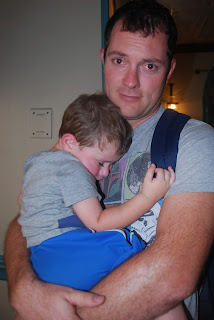The last few visits, Sam has been trending downward with his blood oxygen levels. This is expected as he gets bigger and 'outgrows' his Glenn Circulation from his first surgery. This is our first indicator of need for further procedures. Additionally, things are getting harder for him. Climbing our stairs in the house is tough. Keeping up with his 2 year old brother is getting tough. Walking from one end of his school to the other for lunch is tough. We were prepared at our last few visits to expect the decision for his Fontan surgery to be made at THIS appointment. I prepared myself mentally for this for months now. I was ready to say yes, let's do this.
Naturally, today our cardiologist decided to throw a curve ball and suggest we wait it out a little longer!
This is a good thing, you ask? Well, it's complicated.
We have known from day one that Sam would need this upcoming surgery. We also knew it was essentially the last surgical 'fix'. After this surgery, the clock starts to tick towards transplant. So yes, the longer we wait, we assume we are giving him more time before he has to cross that bridge. But, if we wait it also means he will continue to get weaker. He will continue to struggle with keeping up with his brothers and classmates, and the older he gets the more he realizes he is different. The longer we wait, the longer his body has to survive on super low oxygen levels. He's never been above 85% oxygen, and he is now sitting at 79-80%. Organs start to 'fail' in the 70s. The plan is not to let him get below 75%. But what damage is being done NOW? Studies show kids with cyanotic heart defects have higher incidences of ADD and learning disabilities, among other issues, linked to chronic low oxygen.
If we go ahead and have the surgery, Sam's blood oxygen will end up in the mid to low 90s. He will have more energy for both motor and cognitive function. But, that clock till transplant starts to tick. Along with other clocks. The Fontan surgery has serious side effects. Liver damage and a specific bowel/protein issue are not uncommon and are sadly both fatal and/or limiting to the ability to be listed for transplant. Scar tissue from multiple procedures leaves these kids at risk for heart rhythm issues that lead to pacemakers. Not to mention the addition of several other daily medications he will take for the rest of his life.
Today, our cardiologist said he thinks it's worth waiting another three months to make the decision. We are buying him three months (assuming no emergencies). Potentially, we will buy him three more months if he looks stable at his next check up. We are basically just going to live this out every three months until it's time. When your cardiologist says, "If he were mine, I would wait"...you wait. So we decided low oxygen and poor endurance are worth potentially giving him at least three more months on his clocks.
I know it sounds all doom and gloom. It is just the reality of his condition. He looks so healthy. He's the tallest kid in his class. He's so smart; so funny. No one would guess what is happening inside. It's so easy for us to ignore it, too. We have found little ways to get around it. He still rides in the grocery cart - he can't hardly make it around the store. He still rides in a stroller for long distance stuff - you should see the looks people give us. But once every three months at his check up, we get to face the reality of it all.
I took a beautiful video of part of Sam's Echocardiogram. This is an ultrasound of Sam's heart. A healthy heart has 4 chambers. Separating the upper and lower chamber on each side of a normal heart is a valve. Sam is missing the valve on the right side, so a lower right chamber never developed. Additionally, the upper left and right chambers are missing most of the wall between them. In the video, you can see what looks like one large upper chamber, one functioning valve, and one large lower chamber. Truly, half a heart. I tried to find a normal heart echo for comparison.
Sam's Heart on Echo
Normal Heart on Echo

























































